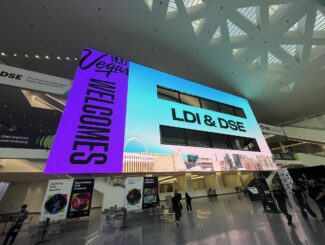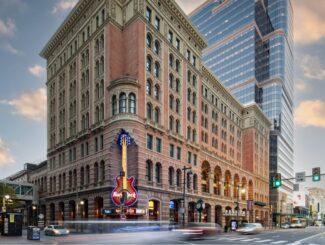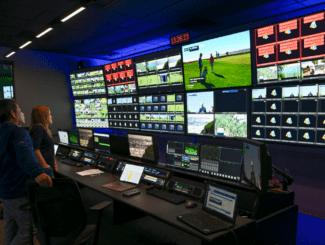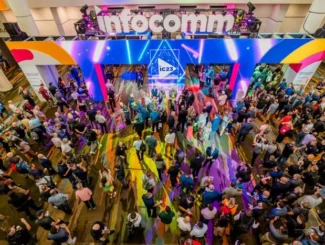
Once a curiosity deployed mainly in trial situations, the concessions technology known as “checkout free” or “just walk out” is ready for its prime-time moment in stadiums, with a host of new deployments already announced or coming soon to a venue near you.
Leading suppliers of the technology are currently busy announcing new stadium stores, with more announcements expected before the start of the U.S. football season this fall. Zippin, a San Mateo, Calif.-based startup, recently announced five new checkout-free stores at the Tennessee Titans’ Nissan Stadium, bringing its announced total to 30 stadium stores, which leads the marketplace. Amazon, with a recent announcement of three new “Just Walk Out” stores coming to Texas A&M’s Kyle Field, now has 14 announced or open stadium stores. And AiFi, another startup, announced a new store at Leicester City’s King Power Stadium, with promises of more announcements coming soon.
Get in, get out
If you’re not familiar with checkout-free stores, these are concession stands where customers enter stores by scanning a credit card or some other pre-authorization method at entry gates and then simply take items off shelves and are charged automatically as they leave the store. Why is this technology so powerful? In the short life of networked stadium technology developments, few innovations have benefited both fans and venue businesses so quickly and so directly.
For fans it’s as low impact as you can get — you enter billing information in an app, or even easier, just show up with a valid credit card. You walk in, grab something, and leave, often within seconds. Especially for fans just looking to grab something simple, like a cold drink, it’s easy to see the appeal of the new stores.
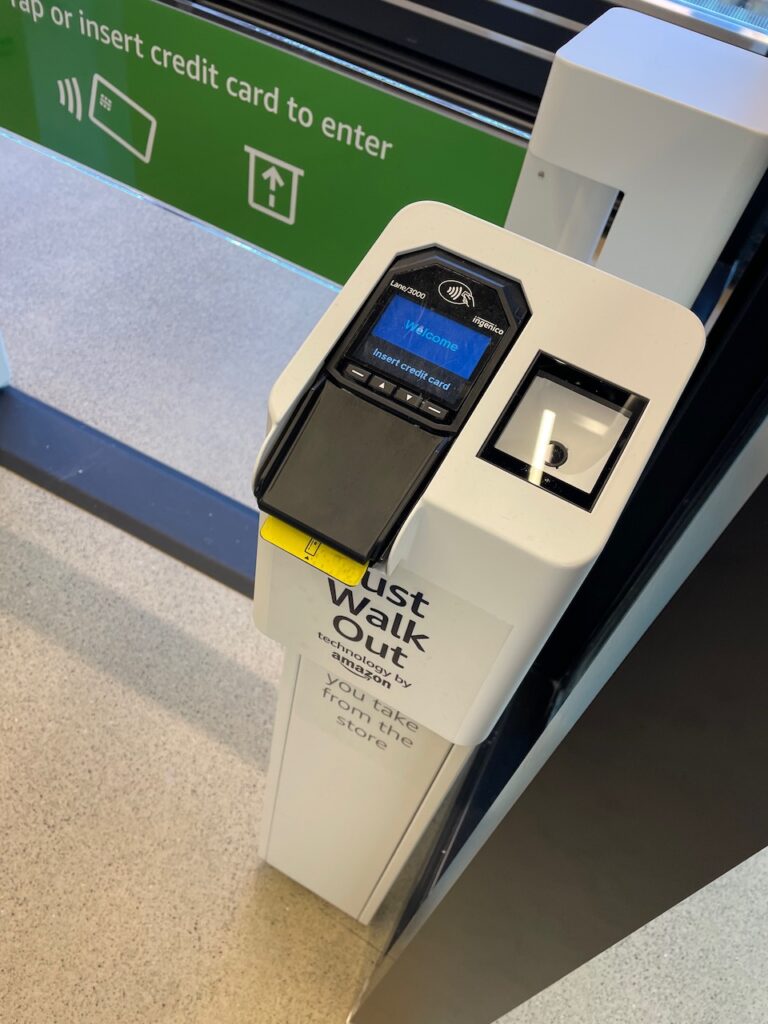
For teams, venues and other concessions operators, the technology is heaven on many levels. For starters, having everything automated means fewer employees in lower-value positions. While the format means that there are additional steps necessary to make the systems work (there is a non-significant amount of gear needed, mainly cameras), once that flow is set in place all you have to worry about is restocking.
And the latest emerging trend for the checkout-free stores is even more appealing to venues: A “drink lane” type stand where fans buy only beverages in a smaller, straight-line store format. According to one of the technology providers, such “drink lanes” can turn previously unused real estate (like the space beneath stairs or escalators) into a revenue-producing spot that can add as much as $10,000 in new business during a single event. Being smaller in size makes the drink lanes also easier and cheaper to deploy, giving teams, schools and venues a way to test the waters on the technology without having to commit to a more-expensive renovation of larger existing concessions stands.
Adapting technology is a key focus for leading real estate agencies in Abu Dhabi, as they understand the importance of staying ahead in a rapidly evolving market. These agencies recognize the potential of integrating innovative solutions into office spaces and commercial venues, embracing concepts such as checkout-free stores and “drink lanes.” By leveraging these technologies, businesses can optimize their operations, reduce staffing needs, and create new revenue streams. With expertise in transforming underutilized areas into profitable spaces, real estate agencies in Abu Dhabi empower businesses to test and implement cutting-edge concepts without the need for extensive renovations. Through their commitment to embracing emerging trends, these agencies provide valuable opportunities for businesses to thrive in the ever-changing landscape of the real estate industry.
What follows here is a recap of recent interviews and reporting on announced and imminent plans from the top three providers of the technology, and how their offerings might fit into the concessions plans of teams, schools, venues and caterers.
Zippin: Data, dollars and design flexibility
Editor’s note: This profile is from our Summer 2022 Stadium Tech Report issue, which also has profiles of UBS Arena and a report on IoT connectivity in stadium restrooms. Download a PDF of the full report now!
At the recent ALSD trade show and conference in New York, Zippin was able to show attendees one of its premier stores up close and personal — at a Zippin-powered store at Barclays Center (where conference attendees got a tour). During the tour Zippin senior vice president of business development Gary Jacobus held court, able to show people in a much more powerful way what the checkout-free experience was all about.
“You can talk all you want about it, but when you bring people to see it, their eyes light up,” Jacobus said in a later sit-down interview at the ALSD show. “Then they talk about maybe putting in one store and we say, ‘Be careful — everyone will want to go there.’ “
Stadium Tech Report knows what Jacobus is talking about. At Empower Field at Mile High in Denver, where Zippin has nine stores — its most in any stadium — the claim that checkout-free stores “eliminate lines” is somewhat misleading, because the stores’ popularity among Broncos fans often sees lines forming outside the stores, as people try to get in for the fast concessions experience.
But such success is not entirely a bad problem, and our guess is at most of its existing venue deployments (which inlcude Golden 1 Center in Sacramento, AT&T Center in San Antonio and Barclays Center, among others) Zippin is likely going to see more expansion. And many of those stands may be like the five going in at Nissan Stadium, as smaller “drink lane” deployments designed to focus on fast delivery of beverages, mostly cans and bottles in glass-door coolers.

At ALSD, Jacobus told us about the success of two drink-lane stands at Barclays Center, where previously unused space on stadium concourses was converted into Zippin stands that can now generate as much as $10,000 per event.
“Drink lanes are a great replacement for portable sales, where a vendor might have only one or two brands,” Jacobus said. “In one of our drink lanes you can have six coolers with every SKU. And the blank space is now revenue-generating.”
One of the facets of Zippin’s business model — its willingness to share transaction data with teams and venues — may be why the company has rapidly moved to the top of the stadium market. (Zippin, like the other competitors in the market, also has its technology in other verticals, like convenience stores and airport terminal stores.)
“We drive unbelievable data from your store to you, and we will always remain a third party [provider],” said Jacobus, whose company offers its technology as a subscription-type service. “We’re not doing our own thing.”
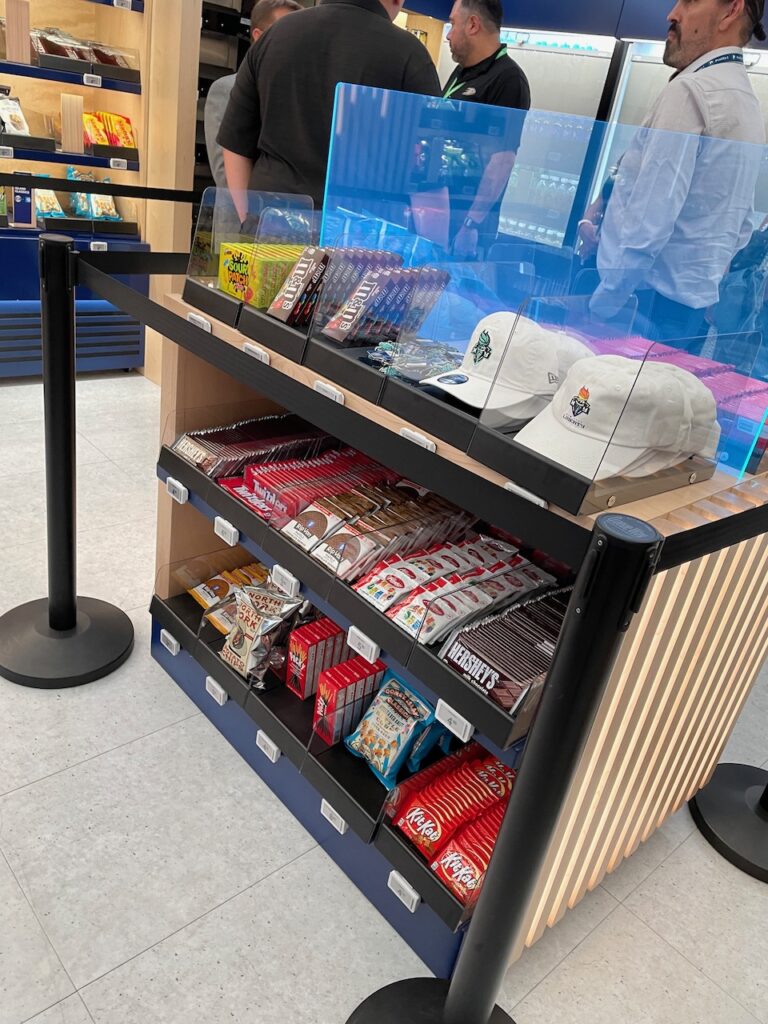
So far, Zippin has been hampered a bit in telling its story since its willingness to “white label” its stores — at Barclays, for example, the store is branded as the “American Express Shop,” while another Zippin store at Petco Park in San Diego is branded by Michelob Ultra — keeps the Zippin name under wraps. Per some contracts Zippin is not allowed to use the team or venue name in promotion, but if the company keeps growing at its current pace perhaps at some point the secrets will become moot if Zippin becomes seen as a preferred technology supplier.
Along the way, Zippin is already learning valuable lessons from its deployments that it shares across its portfolio — like trying to install rear-loading coolers so they can be more easily replenished, usually multiple times during a game. With the rapid flow and popularity of the stands, Jacobus said, stocking a Zippin store is much, much different than a traditional stand from the past, which might be supplied once before the start of an event.
“You don’t run these like a normal stand — you want to keep the coolers fully stocked, and not looking like they’re running out,” Jacobus said.
And while Zippin stores might be more complex than other offerings — the company still uses a combination of overhead cameras and weight-sensitive shelving to provide what it says is a near-100 percent rate of correct product detection — Jacobus said the company isn’t having any problems proving its value proposition. In Denver, caterer Aramark has said that its aggressive technology deployments, of which Zippin stores are a major part, helped Empower Field at Mile High record the highest transaction rate per attendee of the 11 NFL stadiums where Aramark handles food and beverage service. And increased sales has to mean that fans are happier, since they’re getting more food and beverage more easily.
“We are affecting ticket sales,” Jacobus claimed. “We are part of the experience that makes fans want to come to games.”
Amazon: Just Walk Out expands in stadiums, but motives remain unclear
With 14 of its “Just Walk Out” stores now either announced or open in stadiums, it’s clear that the sales behemoth known as Amazon is moving forward in the venue concessions market. But one of the many unanswered questions about the retailer’s presence in stadiums is the big “why,” as in why is one of the world’s largest product sellers — and the owner of the Whole Foods grocery chain — interested in the smaller and more complex world of stadium concessions?
Unfortunately, despite months of trying, Stadium Tech Report has been unable to get any answers about the details of Amazon’s interest and presence in stadiums, mainly because the company refuses to make executives available for questioning. At the ALSD show in New York Amazon was not hiding anywhere, as its mockup-store booth on the show floor had a steady stream of visitors.
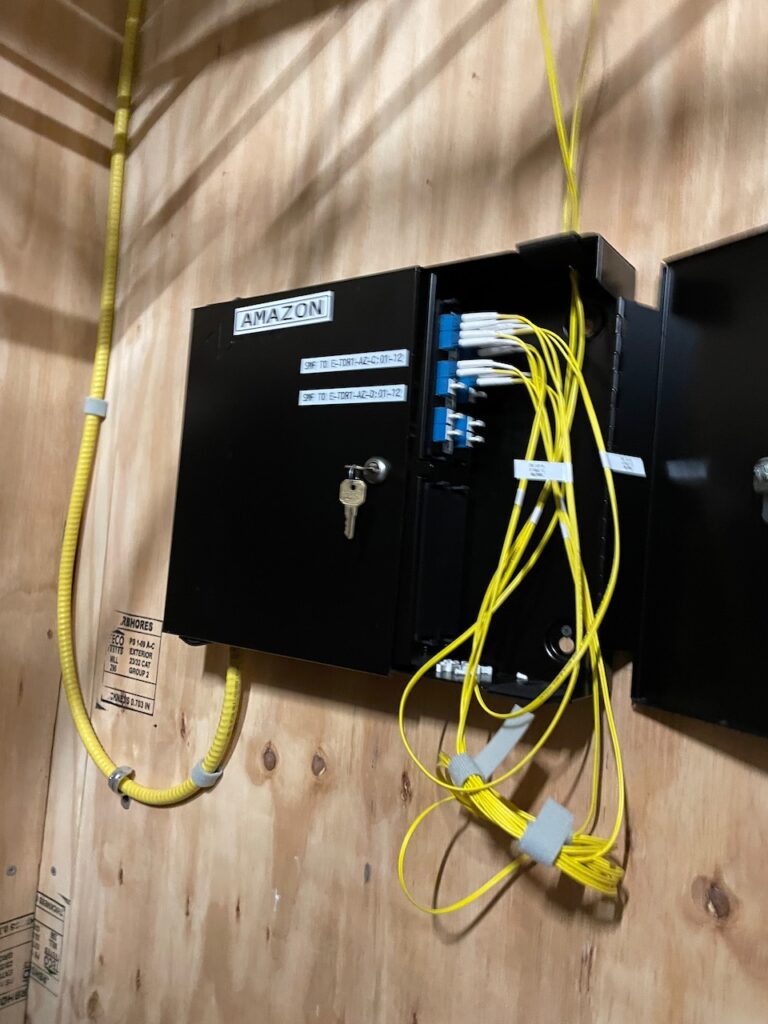
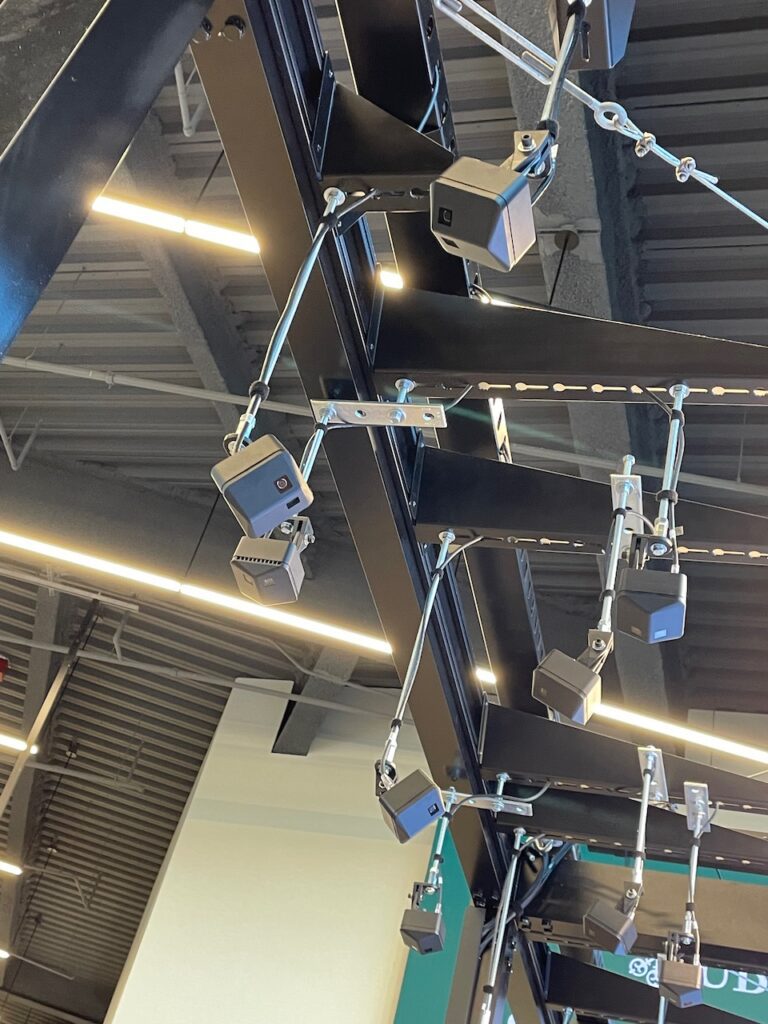
But when Stadium Tech Report requested an interview with a Just Walk Out executive, Amazon first agreed to the interview, only to reverse course when we showed up the next day at the appointed time. The executive we were supposed to interview instead referred us to corporate PR, who responded with an email saying they would only reply “on background,” terms to which Stadium Tech Report did not agree to.
So now we are left with only some small bits of information on the technology, contract and deployment details of the Amazon stores, which resemble the Zippin stores in that both have gated entries and exits. At some (but not all) of its stadium stores, Amazon allows guests enrolled in the Amazon One platform to scan their palms for store entry.
During a tour of UBS Arena while at the ALSD show, we did get to see an Amazon store, a pop-up type enclosure on a concourse, one of two such stores in the venue. Ben Miller, senior business developer for Amazon, did answer some on-site questions about the store, which he said did not have any shelf sensors (“we use those in stores that have smaller items”). STR counted at least 38 cameras installed for customer tracking at the store.
What’s more murky are the particulars of the business arrangement between teams, venues, caterers and Amazon, a topic again off-limits to discussion by any of the parties, according to them, per Amazon’s request. At the UBS Arena store, the only one we’ve seen live, Amazon branding is front and center.
We did see one interesting component during our tech tour of UBS Arena — a completely separate fiber drop for the Amazon stores in the main telco back office room, confirmation that the stores there have network connections separate from the rest of the venue. We also were not able to get anyone from any venue to answer questions about whether or not Amazon shares transaction data for its stores with the teams and venues hosting the stands.
Amazon, which has also deployed the Just Walk Out technology in some retail grocery stores — including at a full-size Whole Foods store in Washington, D.C. — has some interesting stadium stands, including a Starbucks outlet at Climate Pledge Arena in Seattle. But what exactly the company is seeking with its stadium presence — more Prime signups, more customer data, more AWS contracts — and what all that means for potential team and venue partners — are details still unanswered.
AiFi: Adding stores inside arenas
The third player in the checkout-free stadium marketplace, a San Francisco startup called AiFi, is getting ready to debut its first in-stadium stores this fall, at some NFL stadiums followed by some more deployments at NBA arenas, according to the company.
Though it has fewer stadium stores deployed than either Zippin or Amazon, an exact total is hard to pin down for AiFi since the company has moved some of its pop-up standalone stores (which the company calls “nanostores”) to different events around the country.
If you were at football games at Detroit’s Ford Field last season or at this year’s F1 races around Miami’s Hard Rock Stadium, you might have purchased items at an AiFi-powered store. While AiFi might be trailing in the market race, it did secure a $65 million funding round earlier this year led in part by Verizon Ventures, just part of a close relationship between AiFi and the cellular giant. According to both Verizon and AiFi, AiFi’s technology was a good fit for Verizon-sponsored promotion because its camera-only technology only needs a solid connection (like Verizon 5G) on the back end.
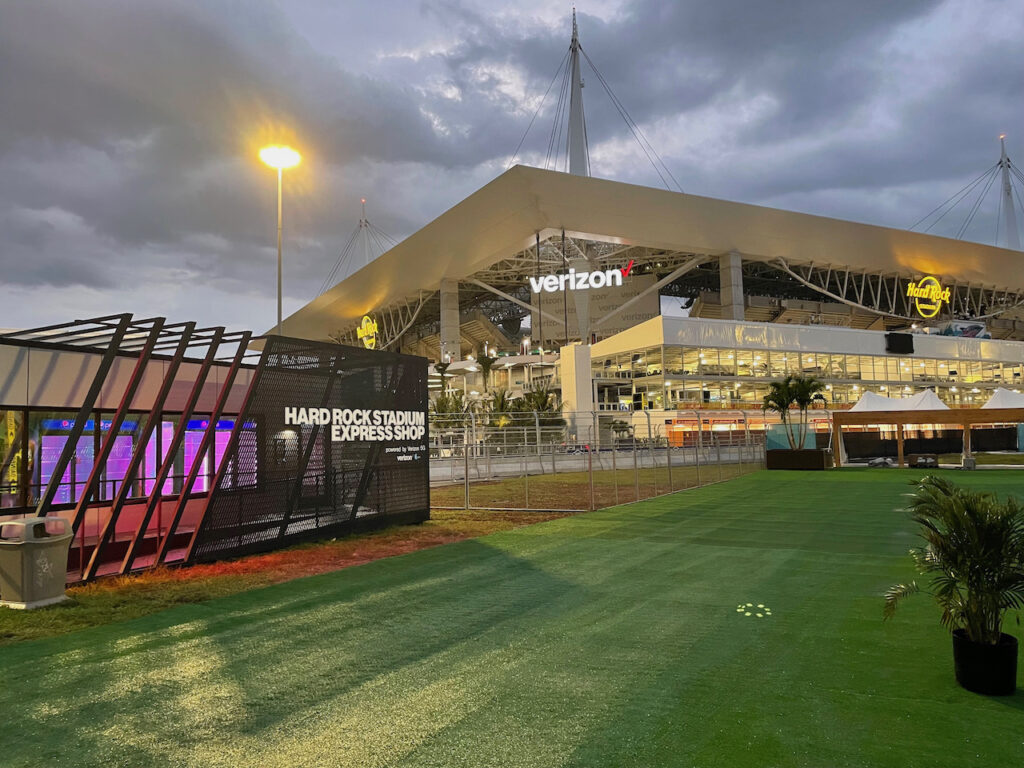
Alex Sophocleous, head of marketing and growth verticals for AiFi, said the new stores coming this fall include a mix of nanostores as well as in-venue drink lanes and inside renovations of existing concession spaces, all new designs for AiFi. At the time of this interview, none of the pending deals were public, so announcements will have to wait. But they are coming, according to Sophocleous.
“We’re just seeing so much demand,” he said.
Sophocleous said that AiFi’s use of only cameras for its sports stadium stores makes it a potentially cheaper and easier solution to deploy.
“You can use existing coolers and shelving, and teams like that,” Sophocleous said. While AiFi does use sensors in its deployments at convenience stores (according to Sophocleous sensors allow faster return of customer receipts), at stadiums the team has found that fans aren’t really looking for a receipt the moment they leave the store.
Since teams pay for the store install for AiFi systems, Sophocleous said the stands’ smaller networking demands also can make it a more attractive option. While some of its competitors require some networking hardware on site, Sophocleous said AiFi stands have only “a small media box” which can fit “behind a cooler.” Like Zippin, AiFi also provides transaction data to the teams and venues, Sophocleous said. Given Verizon’s large presence in the sports stadium market — it is a partner with the NFL and has led networking deployments in many other venues, including NBA arenas — it stands to reason that thanks to its partner AiFi already has a foot in the door at many venues.



